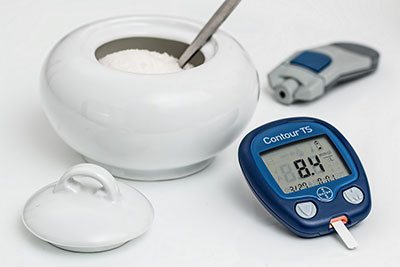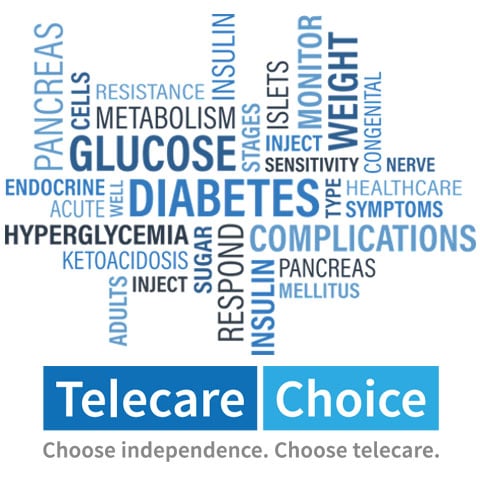One person every two minutes is diagnosed with diabetes. Currently there are four million people living with diabetes in the UK. It’s a lifelong condition that means a person’s blood glucose (sugar) levels are too high for too long.
Our glucose blood levels are balanced by a hormone called insulin. Insulin allows the absorption of glucose into our cells. Without this, the glucose has nowhere to go and accumulates in our blood vessels. Glucose comes from the food we eat, and is essential to keeping up our energy levels.
There are two main types of diabetes:
• Type 1 accounts for 10% of diabetes cases. In type 1 our pancreas does not produce any insulin.
• Type 2 accounts for the other 90% of cases. Not only may the pancreas not produce enough insulin but our cells do not respond to any insulin. Our cells have ‘receptors’ attached to them; they need to be a specific shape to be complementary to insulin for the cell to react to insulin. In type 2 diabetes these receptors change shape meaning there is no response, therefore glucose isn’t absorbed into our cells.
Diabetes Causes
Type 1 diabetes is an autoimmune condition that is mostly inherited from our parents. Our immune system is designed to ‘kill’ any unwanted or harmful cells. However, in type 1 something goes wrong with our immune system and it begins to attack healthy cells, called beta cells, that produce insulin.
Type 2 diabetes is also inherited but other risk factors can cause it. These include: being over 40, having South Asian, Chinese, Black African or African-Caribbean ethnicity, or being overweight.
Diabetes Symptoms
Symptoms are similar for both types. The main symptoms are:
• Increase in frequency of urinating, especially at night.
• Extreme fatigue.
• Feeling extremely thirsty.
• Weight and muscle loss.
• Itchiness around the genital area.
• Blurred vision.
• Cuts healing slowly.
Type 1 will develop rapidly in young people, usually within a few days. In adults, it may take a few months. Type 2 diabetes tends to occur later in life.
Hyperglycaemia and hypoglycaemia
Both occur in people living with diabetes.
‘Hyper-’ is Greek for ‘over’ and ‘glycaemia’ means the presence of glucose in the blood. Hyperglycaemia is when blood glucose levels become too high. This can be due to eating too much, illness, or ineffective diabetes treatment.
‘Hypo-‘ is Greek for ‘low’. Hypoglycaemia occurs when blood glucose levels become too low. This happens when you inject insulin and too much glucose is absorbed by cells. Also, it can be caused by: skipping a meal, vigorous exercise, or drinking alcohol without eating much. Blood glucose levels can be returned to normal by eating or drinking something containing a lot of sugar. If a person becomes unconscious because of this, an injection of glucagon is given and glucagon breaks down into glucose. Symptoms of hypoglycaemia include: 
• Shaking
• Irritability
• Nausea
• Feeling weak
• Feeling confused
• Hunger
• Slurred speech
Diabetes Diagnosis
A urine sample is taken and tested for glucose. Usually, our kidneys don’t allow glucose to pass into our urine but this can happen if you have diabetes.
If these results are positive, a blood test called glycated haemoglobin (HbA1c) is done. This test is also used to see if your diabetes is being controlled whilst you’re having treatment. This would be taken at least twice a year, or more frequently if you’ve just been diagnosed with diabetes, your blood glucose is continuously too high, or your treatment plan has been altered.
Diabetes Treatment
Currently, there is no cure for diabetes. Therefore, treatment focuses on balancing blood glucose levels and alleviating symptoms. For type 1 diabetes, insulin injections solve the issue of being unable to produce insulin. Also, there is insulin pump therapy. This involves a small device that contains insulin. It provides a continuous flow of insulin into your blood vessels, which removes the need for injections.
For type 2 diabetes, you can have insulin injections. However, they may be inappropriate as your cells are unable to respond to insulin. Having a healthy, balanced diet, losing weight if you are overweight, and exercising regularly will help to balance blood glucose levels.
As part of these lifestyle changes, you should also quit smoking as your risk of developing a cardiovascular disease increases with diabetes. It is also recommended that you seriously limit your alcohol intake by never exceeding the daily amount recommended. You should also never drink on an empty stomach.
In addition, taking medications can help.
• Metformin will decrease the amount of glucose your liver releases into your blood and helps makes cells respond to insulin.
• Sulphonylureas will increase how much insulin the pancreas produces.
• Pioglitazone will make cells more responsive to insulin.
Complications
If not treated, numerous complications can occur. High blood glucose levels can lead to damaged blood vessels, nerves, and organs, which can cause numerous issues:
• Stroke or coronary heart disease (CHD) – You can be five times more likely to experience these conditions.
• Atherosclerosis – Blood vessels narrow due to the build-up of deposits like fat. Therefore, less blood, which carries oxygen, can be delivered to your heart. This can lead to angina. Atherosclerosis can completely block a blood vessel in your heart leading to a heart attack, or in your brain causing a stroke.
• Peripheral neuropathy – This causes tingling sensations in the fingers and toes and numbness which can cause ulcers. One in 10 people with diabetes will develop a foot ulcer.
• Diabetic retinopathy – Your retina, a light sensitive tissue in your eyes, becomes damaged because there’s not a continuous blood supply.
• Kidney disease – Damaged blood vessels means the kidney can’t function properly.
Useful Tips
• Ask your GP or nurse to teach a close friend or relative how to inject insulin. This is helpful in case you’re unable to.
• Diabetes can cause cuts to heal slower. This combined with damaged blood vessels this can lead to foot ulcers which can cause infections. You may not even feel cuts due to nerve damage. It’s important to regularly check your feet for any swelling and cuts that do not heal. Also, keeping your nails short and washing your feet every day with warm water helps.
• There’s a NHS diabetic eye screening programme where your eyes are checked annually for any damage.
• Consider a personal alarm for peace of mind at home and quick access to help if you experience a diabetic emergency.
Sources used for this article: NHS, Diabetes UK.
Editor’s Note: This article was updated on 5th December 2023 to reflect current information.




